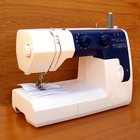
They say that seeing is believing, but this maxim usually doesn’t hold true for hems. Unless it is decorative, a hem should be invisible from the right side. Sewing a hem with hem tape obviously adds one step to the hemming process; instead of just hand-sewing the hem in place, you have to sew the tape to the bottom of the fabric first. But this extra step is worth it, for hem tape secures the raw edges of the fabric and effectively blocks snags and tears that can cause hems to sag, droop and require repairs over time.
Let the fabric hang on a hanger for 24 hours. If it is still wrinkled, iron it to ensure the piece is flat before you proceed. Wrinkles could affect your measurements and the evenness of the hem.
Measure your piece to double-check that you know how much you want to take up. Most clothing patterns allow for a 2- to 3-inch hem allowance. Home décor items usually afford far less.
Pin the tape to the right side of the fabric. (If you are using double bias tape, be especially careful to insert the fabric evenly between the two pieces of overlapping tape.)

Stitch close to the bottom edge of the hem tape.
Refer to the measurements you made above and pin the fabric to the desired hem length. If you are making a 2-inch hem, use a ruler every few inches and insert a pin, repeating this process until the fabric is completely pinned in place.
Iron the hem into place, starting at the bottom of the fabric and working your way up to the pins. Be careful not to dislodge the pins from the fabric with the nose of the iron.
Finish the hem by hand or with a machine. If by hand, make sure that you carefully catch a thread of fabric in your needle so that the hem doesn’t show on the right side. Sew the hem on a machine only if it comes equipped with a blind stitch.

Press the hem again to ensure that it lays flat.
Related Articles

How to Do an Alteration on a Satin Gown

How to Remove Iron-On Hemming Tape

How to Remove Adhesive No-Sew Tape

How to Unwrinkle Velvet

How to Hem a Shirt Collar

Types of Pant Hems

How to Hem T-Shirts

How to Make a Cool Tattered Skirt

How to Make a Satin Waistband Tutu

How to Hem a Sequin Dress

How to Make a Twirly Skirt

How to Hand Sew a Belt Loop on Pants

How to Repair Denim

How to Cut a V-Neck on a Hoodie

How to Hem Pants Without Sewing

How to Lengthen a Suit Jacket

How to Remove Wrinkles From Polyester ...

How to Sew a Western Shirt Pattern

How to Fix a Ripped Pocket

How to Attach Patches With Velcro
References
- “Sewing Made Easy”; Dorothy Sara; 1977
Writer Bio
Mary Wroblewski earned a master'sdegree with high honors in communications and has worked as areporter and editor in two Chicago newsrooms. She launched her ownsmall business, which specialized in assisting small business ownerswith “all things marketing” – from drafting a marketing planand writing website copy to crafting media plans and developing emailcampaigns. Mary writes extensively about small business issues, andespecially “all things marketing.”
Photo Credits
Jupiterimages/Polka Dot/Getty Images